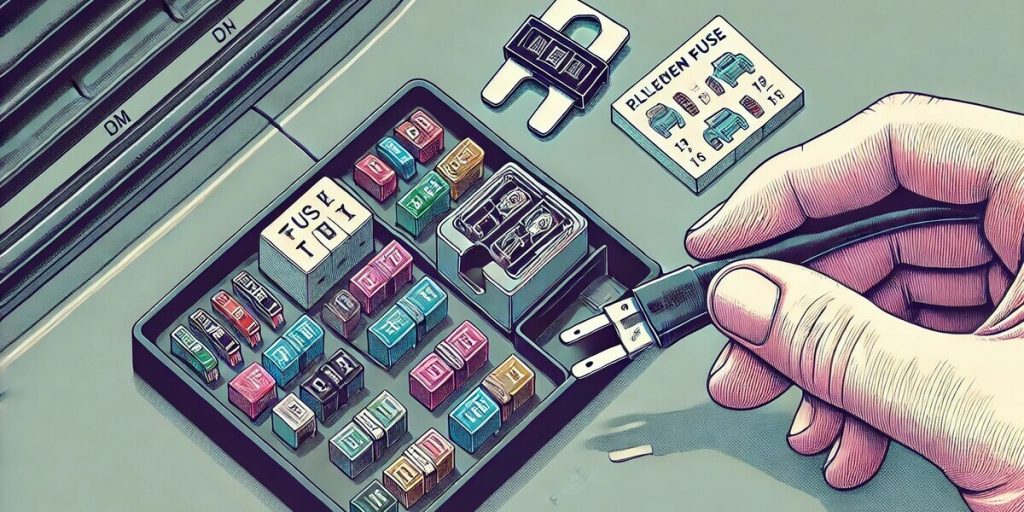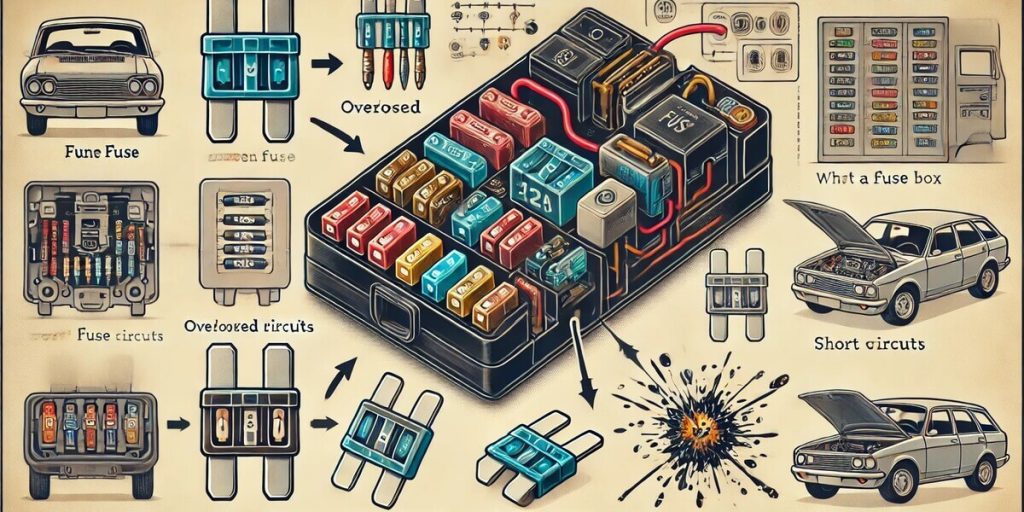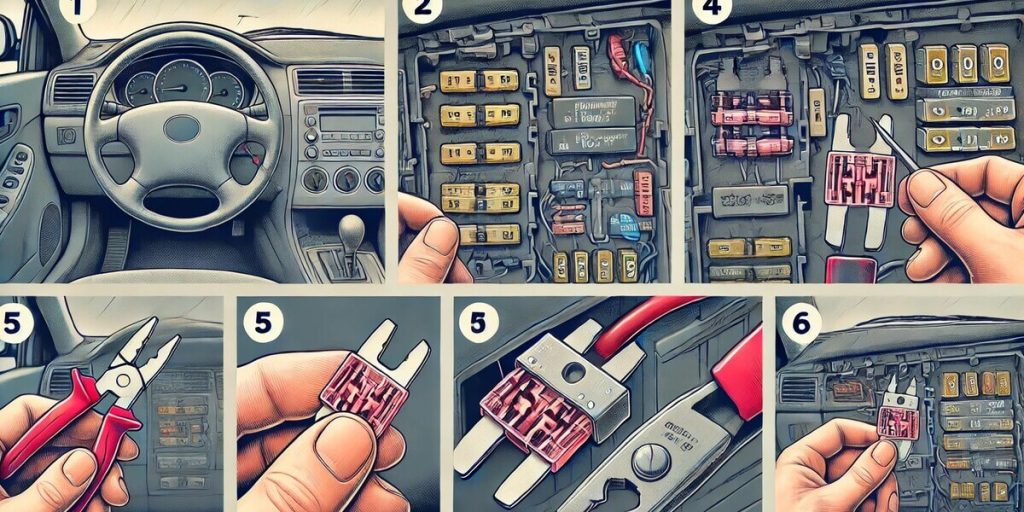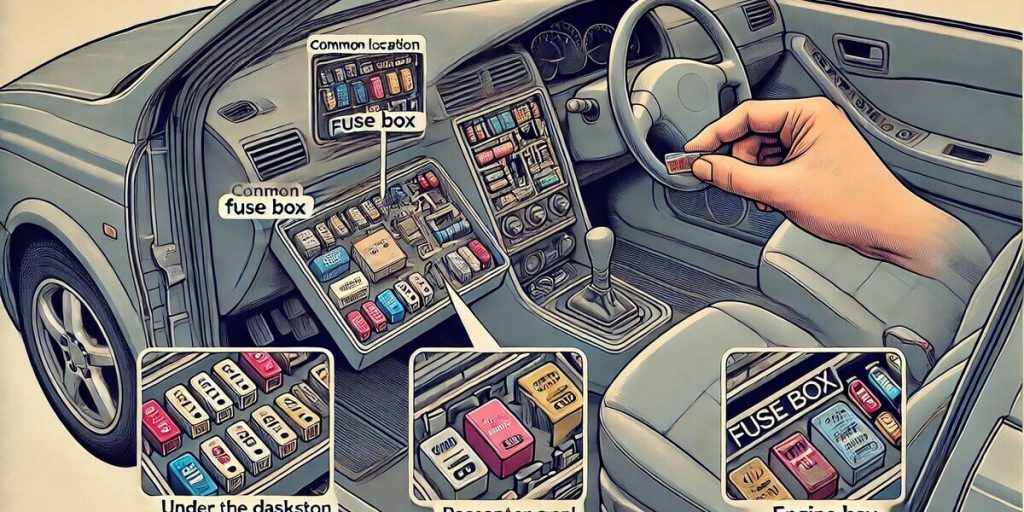Last Updated on February 22, 2025 by Mark S. Taylor
Last winter, my car wouldn’t start on a freezing morning, and I panicked. I thought the battery had died, but after a little digging, I realized it was just a blown fuse. If you’ve ever had your headlights, radio, or power windows suddenly stop working, you might be dealing with the same issue. The good news? Learning how to fix a blown fuse in a car is easier than you think, and you don’t need to be a mechanic to do it. In this guide, I’ll walk you through everything—from spotting a blown fuse to replacing it like a pro. Let’s get your car back in action!

Contents
What Is a Car Fuse and Why Does It Blow?
Let me explain something simple but important: car fuses. Think of them as tiny protectors for your car’s electrical system. Their job is to stop too much electricity from flowing through. If the current gets too high, the fuse “blows,” breaking the circuit. This protects your car’s electronics from damage.
So, why do fuses blow? Here’s the quick answer: A blown fuse happens when there’s too much electricity flowing through it. There are a few common reasons for this:
- Overloaded Circuits: Picture this—you plug in too many things at home, and the power trips. Cars work the same way. Too many accessories, like phone chargers or heated seats, can overload the system.
- Short Circuits: A short happens when wires touch where they shouldn’t. I once had a dash cam installed, and a loose wire behind the dashboard caused a short. The fuse blew right away.
- Faulty Wiring or Parts: Old or damaged wires can cause problems. Sometimes, a part in your car just stops working right and sends too much current through the fuse.
- Wear and Tear: Fuses don’t last forever. Over time, they get weaker. If your car is older, some fuses might need replacing simply because they’re worn out.
Here’s a story to make it real: Last summer, I upgraded my sound system. Everything seemed fine until one day, my radio stopped working mid-drive. I checked the manual, found the fuse box, and saw the blown fuse. Turns out, the new amplifier was pulling more power than the old setup could handle. Now, I always check the amperage before adding anything new.
The bottom line? A blown fuse isn’t scary—it’s just your car saying something’s wrong. Whether it’s an overload, a short, or old age, finding the cause helps you fix it fast. Next, we’ll talk about how to spot a blown fuse so you can take action.
How to Know If a Car Fuse Is Blown
A blown fuse can feel like a mystery at first, but the signs are usually easy to spot. The most obvious clue? Something in your car suddenly stops working—maybe your radio goes silent, your headlights won’t turn on, or your power windows refuse to budge. When a fuse blows, it cuts off power to a specific component, so if one thing stops working while the rest of your car functions fine, a blown fuse is a likely culprit.
Visual inspection is the fastest way to confirm a blown fuse. Most car fuses are small, transparent plastic pieces with a thin metal strip inside. If that strip is broken or you see black scorch marks, the fuse is toast. To check, locate your car’s fuse box (usually under the dashboard or hood), pull out the suspect fuse, and take a close look. If the metal inside is intact, the problem might be elsewhere.
For a 100% accurate test, use a multimeter or fuse tester. Set the multimeter to continuity mode, touch both fuse prongs with the leads, and see if it beeps. No sound? That fuse is dead. If you don’t have a multimeter, swapping the questionable fuse with a working one of the same amperage can also help confirm the issue.
Quick tip: Not sure which fuse controls what? Check your owner’s manual—it has a fuse diagram that maps out which fuse belongs to which function. Some cars also print this inside the fuse box cover. Finding the right fuse can save you time and get your car running smoothly again.

Locating Your Car’s Fuse Box
Finding your car’s fuse box is easier than you think. Most cars have fuse boxes in two main spots: under the dashboard or in the engine bay. Some vehicles even have more than one. If you’re unsure where to look, grab your owner’s manual—it has a diagram that shows exactly where to find it.
Inside the car, the fuse box is usually under the dashboard, near the driver’s seat. It might be on the left side by the pedals or hidden behind a small panel on the passenger side. Some cars make you open the glove box or remove a cover to find it. If you don’t spot it right away, check near your feet or look for a latch.
Under the hood, the fuse box is often next to the battery. It’s covered with a plastic lid that pops off easily. This box holds fuses for major systems like the engine and cooling fans.
I remember the first time I had to change a fuse in my car. I searched under the steering wheel for 10 minutes, only to realize the box was hidden behind a tiny panel near the door. Now, I always check the manual first. If you’re having trouble, don’t stress—once you find it, replacing a fuse is quick and easy!
Tools You’ll Need to Replace a Blown Fuse
Replacing a blown fuse is easy, but having the right tools makes the job even smoother. The good news? You probably already have what you need. Here’s a quick list to get you started.
1. Fuse Puller (or a Simple Alternative)
Many cars come with a fuse puller—a small plastic tool that makes removing fuses a breeze. You’ll usually find it inside the fuse box or your car’s toolkit. No fuse puller? No problem! A pair of needle-nose pliers, tweezers, or even your fingers can do the trick if you’re careful. Just be gentle to avoid damaging the fuse or connectors.
2. Replacement Fuses (Correct Amperage Rating)
Fuses come in different sizes and amperage ratings, usually 5A, 10A, 15A, or 20A. Always replace a blown fuse with one of the exact same rating—using the wrong one can cause electrical damage.
Pro tip: Keep a small pack of spare fuses in your glove box. It’s a lifesaver when you’re on the road!
3. Multimeter or Test Light (Optional but Helpful)
If you’re unsure which fuse is blown, a multimeter or test light can help. A multimeter checks if electricity is flowing through the fuse, while a test light quickly identifies dead fuses by lighting up when there’s power. Not a must-have, but definitely handy!
I once had to change a fuse at night in a parking lot with no tools. I ended up using a pair of tweezers from my glove box to pull out the fuse. Not ideal, but it worked! If you’re ever in a pinch, a little creativity goes a long way. Now, I always keep a fuse puller and spares in my car—lesson learned!

Step-by-Step Guide to Fixing a Blown Fuse
Fixing a blown fuse is one of the easiest car repairs you can do. No need for a mechanic—just a few minutes and a replacement fuse, and you’re good to go! Here’s how to do it safely and correctly.
1. Turn Off the Car and Disconnect the Battery
Before touching anything, turn off your car to avoid electrical shocks. For extra safety, disconnect the battery’s negative terminal—this step is optional but helps prevent accidental shorts.
2. Locate the Affected Fuse
Use your owner’s manual to find the fuse box and identify the fuse that controls the malfunctioning component. Most fuse boxes have a diagram inside the cover to make it even easier.
3. Remove the Blown Fuse
Grab a fuse puller (or tweezers, pliers, or even your fingers) and gently pull the fuse straight out. Be careful not to damage the surrounding fuses or connectors.
4. Inspect the Fuse for Damage
Hold the fuse up to the light. If the metal strip inside is broken or you see black scorch marks, it’s blown. If it looks fine, test it with a multimeter or fuse tester to be sure.
5. Insert a New Fuse with the Same Amperage Rating
Match the amperage rating (printed on the fuse) with the old one—using the wrong type can cause bigger electrical problems. Push it firmly into place.
6. Reconnect the Battery and Test the Component
If you disconnected the battery, reconnect it and start the car. Check if the previously dead component is working. If it is, you’re done! If not, you may have a deeper electrical issue.
I once had my radio go out mid-drive, and replacing the fuse brought it back instantly. It’s a quick fix that can save you time, money, and frustration. Just be sure to use the right fuse and handle everything with dry hands to stay safe!
How to Fix a Blown Fuse Without Tools
So, you’ve got a blown fuse, but no tools? No worries! You can still get the job done with a little creativity.
1. Use Your Fingers (If There’s Enough Grip)
Some fuses stick out just enough that you can grab and pull them out with your fingertips. Try wiggling it gently side to side while pulling straight out. If it doesn’t budge, move on to the next trick.
2. Grab a Pair of Tweezers or Needle-Nose Pliers
If you have tweezers in your car (or even in a makeup bag), they can work as a quick substitute for a fuse puller. Just make sure they’re plastic or have insulated handles to avoid any risk of a short circuit.
3. Use a Flathead Screwdriver
A small flathead screwdriver can be carefully wedged under the fuse to gently pry it up. Just be careful not to damage the surrounding fuses or metal connectors.
4. Paperclips, Keys, or Even a Credit Card Edge
In a pinch, a paperclip or the corner of a credit card can help nudge a fuse loose. Just be extra careful to avoid touching any exposed metal parts inside the fuse box.
I once had to replace a fuse at a gas station with nothing but a pair of tweezers from my first-aid kit—and it worked! The key is to stay patient and avoid forcing anything, so you don’t cause more damage. Once the fuse is out, pop in a new one, and you’re back on the road!
Special Cases: Fixing a Blown Fuse in the Cigarette Lighter
A blown fuse in the cigarette lighter is more common than you might think. If your car’s phone charger, dash cam, or GPS suddenly stops working, chances are the fuse for the 12V power outlet has blown. The good news? It’s an easy fix!
What Causes a Cigarette Lighter Fuse to Blow?
- Overloading the socket – Plugging in too many high-powered devices at once can fry the fuse.
- Foreign objects inside the socket – Coins, dirt, or even small pieces of metal can cause a short circuit.
- A faulty charger or accessory – A defective phone charger or adapter can create a power surge.
How to Fix It
- Locate the fuse box (usually under the dashboard or in the engine bay).
- Check the owner’s manual to find the fuse linked to the cigarette lighter (often labeled “12V” or “power outlet”).
- Remove the blown fuse and inspect it for a broken filament or burn marks.
- Replace it with a fuse of the same amperage rating—never use a higher-rated fuse, as it can damage the wiring.
I learned this lesson the hard way when my kids dropped a coin into the lighter socket. The whole thing shorted out instantly! I replaced the fuse in minutes, but now I keep a cheap plastic plug in the socket when I’m not using it—problem solved! If your cigarette lighter keeps blowing fuses, check for debris inside the socket or test your charger on another outlet.

Why Does My Car Keep Blowing Fuses?
If your car keeps blowing fuses, something bigger is going on. A fuse blows when too much power flows through it, but if it happens repeatedly, there’s an underlying issue. Let’s break down the most common causes.
1. Bad Wiring or Poor Grounding
Loose or damaged wires can cause a short circuit, making the fuse blow instantly. Bad grounding can also lead to unstable power. If you notice flickering lights or a burning smell, check the wiring.
2. A Faulty Electrical Part
A failing alternator, starter, or power window motor can pull too much power, overloading the fuse. If a fuse only blows when you use a certain feature, that part might be the problem.
3. Using the Wrong Fuse
Always replace a fuse with the same amperage rating. If you use one that’s too weak, it will blow too fast. If it’s too strong, it could damage your car’s wiring. Check your owner’s manual before swapping fuses.
I once had my radio fuse blow every few days, and I thought my car was cursed. Turns out, my cheap phone charger had a short and was overloading the circuit. Unplugging accessories and testing again can help find the issue. If the problem keeps happening, it’s time to see a mechanic before it leads to bigger repairs.
Cost of Replacing a Car Fuse
Fixing a blown fuse is one of the cheapest car repairs you can do. Whether you handle it yourself or go to a mechanic, it won’t cost much.
DIY Cost: $5–$20
A pack of replacement fuses costs $5 to $20 and usually includes different sizes. If you already have a fuse puller, you’re all set. This is a quick and budget-friendly fix.
Professional Repair: $50–$150+
If you go to a mechanic, expect to pay $50 to $150 for labor and diagnosis. Shops charge for their time, even for simple jobs. If your fuse keeps blowing, a mechanic can check for deeper issues.
I once paid $80 at a shop just to replace a $2 fuse—never again! Now, I keep spare fuses in my glove box and fix them myself. If the problem is just a blown fuse, doing it yourself saves time and money.
Tips to Prevent Car Fuses from Blowing
Dealing with a blown fuse once is fine. Dealing with it over and over? That’s frustrating. Here are some simple ways to stop fuse issues before they start.
1. Don’t Overload the Circuits
Plugging in too many accessories at once (like a phone charger, dash cam, and seat heater) can overload the system and blow a fuse. Stick to low-power devices and avoid using multiple high-draw items at the same time.
2. Check for Worn or Corroded Wiring
Old, frayed, or corroded wires can cause short circuits. Every few months, inspect visible wires (especially near the battery and fuse box) for damage. A small wiring issue today can turn into a big electrical problem later.
3. Always Use the Correct Fuse Rating
A fuse must match the required amperage. Too low? It will blow too easily. Too high? It could damage the wiring. If you’re not sure, check your owner’s manual or the fuse box cover.
4. Keep Spare Fuses in Your Car
A blown fuse is an easy fix—if you have a replacement. I keep a small toolkit with extra fuses and a multimeter in my glove box. It’s saved me more than once! You never know when you’ll need one.
I learned my lesson after blowing the same fuse twice in a week because of a faulty charger. Now, I check my accessories before plugging them in. A little prevention goes a long way in keeping your car’s electrical system running smoothly!
FAQs About Fixing Blown Fuses in Cars
Q: How do I remove a car fuse without a tool?
A: Use needle-nose pliers, tweezers, or even your fingers if the fuse is accessible. Be gentle to avoid damage. A small flathead screwdriver can also help pry it out.
Q: Can I replace a blown fuse myself?
A: Yes! Replacing a fuse is easy and takes minutes. Turn off the car, locate the fuse box, remove the blown fuse, and replace it with one of the same amperage.
Q: What happens if I put the wrong fuse in my car?
A: Using the wrong fuse can cause electrical issues. A lower amperage fuse will blow quickly, while a higher amperage fuse can overheat wires and cause damage.
Q: Where is the fuse box located in my car?
A: Most fuse boxes are under the dashboard or in the engine bay. Some cars have multiple fuse boxes. Check your owner’s manual for the exact location.
Q: Why does my cigarette lighter keep blowing fuses?
A: This happens due to overloading, a faulty charger, or debris inside the socket. Try a different charger and check for foreign objects in the outlet.
My Final Thoughts on How to Fix a Blown Fuse in a Car
If you like quick, budget-friendly car fixes, learning how to fix a blown fuse in a car is a skill worth having. It’s simple, takes just a few minutes, and saves you money on unnecessary repairs. But if your car keeps blowing fuses, it could mean a bigger electrical issue—that’s when a mechanic is your best bet. I’ve been there, and trust me, a little troubleshooting can go a long way. Keep spare fuses in your car, stay prepared, and you’ll never be stuck with a dead circuit again!
